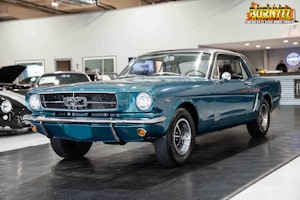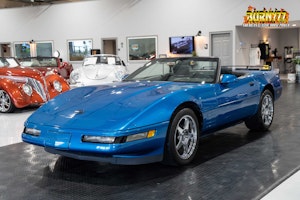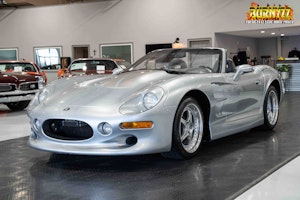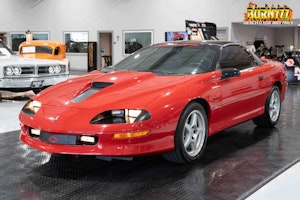Media | Articles
The Little Rollers That Changed Engines Forever
The design and construction of the engines that power automobiles have evolved by both evolution and revolution over the nearly 140 years since Karl Benz’s Patent-Motorwagen chuffed about the countryside. Benz’s single-cylinder required numerous steps just to start. It could only run for so long before requiring at least some amount of fiddling. In comparison, modern engines are comically complex in their operation but wildly simple to maintain. What changed?
Well, lots of things. Material science has progressed leaps and bounds in the last 100+ years, but all the formulations of steel and aluminum in the world would be useless without precise control of an engine’s internal systems. That’s why so many revolutions in engine design centered on the orientation and actuation of the intake and exhaust valves—together known as the valvetrain. However, the key to a reliable and dependable modern valvetrain boils down to a simple roller.

The roller in question sits at the tip of the lifter, a key piece that translates the rotational motion of the camshaft into the linear motion of the pushrod, which acts on the rocker arm to open the valve. Spring pressure keeps the valves closed and, as engines have adopted higher and higher redlines, spring pressures have increased to better control the valves and ensure proper cycling of fuel and air. (Yes, I know desmodromic valvetrains exist, but they are relatively uncommon compared to traditional spring closures.)
That additional spring pressure has turned out to be the root of some interesting automotive developments. As these spring pressures were increasing, governments began to mandate emissions equipment. The addition of catalytic converters, and other tailpipe-emissions monitors and cleanup efforts, conspired to take certain additives out of regular engine oils. The main additives that got removed belonged to a family of compounds (zinc dialkyldithiophosphates, or ZDDP) that are critical to cushioning the connection between the lifter and the camshaft. Jason Fenske of Engineering Explained recently covered the topic in-depth, and his YouTube video is worth watching:
Marketplace
Buy and sell classics with confidence
Lifters have a slight dish on the face that rides on the cam, but to the naked eye they look flat—hence the name. Without proper lubrication between the cam and lifter, those flat tappet lifters would either be eaten away by the cam, or the lifter would wear away the camshaft. Either way, not good.
While ZDDP was common in oils, flat-tappet lifters worked great for decades, but when those zinc compounds were removed, and as spring pressure increased and camshaft profiles grew more aggressive, damage to the lifter or camshaft became significantly more common. Replacing the flat tappet lifter with one that incorporated a roller that rode on the camshaft solved many problems and eliminated the need to change your oil formula.
These simple rollers changed the game and even opened the door to more performance. Since the reduction in friction lowered the risk of wiping material from the lifter or camshaft, the profile of the camshaft lobe could be altered in ways previously unimaginable. Higher lift with a more aggressive ramp than ever was not an issue, since the roller rotated with the cam. No additives were needed, so the emissions systems functioned as intended and maintenance intervals could stretch ever so slightly.

Friction is the enemy of an engine. Friction takes horsepower and turns it into heat and destruction. Essentially we have found two ways to reduce friction in the valvetrain: Oil additives like ZDDP and lower-friction components like roller lifters and rocker arms. Luckily now we have access to parts that can retrofit vintage engine designs with roller valvetrains, and we can purchase specially formulated oils or additives that will keep our engines running for a long time—as long as we maintain our vehicles properly and choose the correct oils.














At 7:25:
“Engineering is a compromise…more is not always better…except horsepower! More is always better.”
An even better way is to eliminate the lifters entirely and use any version of overhead cam/ tappet valve management. The most reliable and “bulletproof” engines have been using that for half a century.
And btw, if your flat lifters are dished they are beyond worn out. They should be crowned
One reason I decide to wait another year until 1985 when Ford added roller lifters to the venerable 5.0 Windsor for the first time. The other, was a dramatic…at least for that time…increase in horsepower.
Maybe I missed this in the comments, but the significant development is not the roller lifter per se (as said, they’ve been around a long time, especially in the aftermarket high-performance space), but the HYDRAULIC roller lifter, which gives both the geometry and lubrication benefits of “mechanical” roller lifters, plus the reduced noise and adjustment requirements of the hydraulic flat tappet, which was the mainstay of American production engines previously for those reasons.
In paragraph 5, it is stated “Lifters have a slight dish on the face” – that may be when they’re worn – but when they’re new they have a slight crown on their face. This, along with the taper on the cam lobe, as was previously mentioned in the comments, allow that spinning of the lifter in operation.
You beat me – I agree with your explanation being correct
The modern roller lifter use and cam design owes itself to one company and one man: Harley-Davidson and Chet Herbert. The first is a familiar name, the 2nd maybe not. Harley’s have been using a lightweight roller lifter in their engines going all the way back to their Knuckle head era. It was part of the reason that engine made so much reliable power unmatched by competitors then.
If you’ve never heard of Chet Herbert, you may have heard of Chet Herbert performance cams (company) OR his son Doug Herbert who was a very successful Top Fuel drag racer.
Chet used to drag race and land (top speed) competitions with Harley’s je built and modified. One particular accident left Chet severely injured and he could not ride motorcycles anymore. So he turned his attention to engine building / camshaft grinding full time. He was the 1st to use a modified HD roller lifter in a small block Chevy & designed a very aggressive (at that time) cam profile to take full advantage. The rest is history 🙂
I heard that Chet Herbert’s disability was from polio, not a racing accident. He lived to be 81, rare for a drag racer or a polio victim (although cam grinders live about forever, Iskendarian says).
A good follow-up article for this one might be a thorough look at the cam-less systems in proposed and current use. Actuating a poppet valve through computer assisted hydraulic or electro-mechanical means would enable multiple dynamic cam profiles that adjust to all sorts of variables. We should also look at alternatives to the poppet valve. Computer mediation is the only really new thing in automotive power trains and suspensions.
Leave it to the company that makes more internal combustion engines than any other. Honda does not use hydraulic lifters, and they are doing just fine that way.
Honda Gold Wings ,1500,1200. Bunches of Honda Shadows. CB 650sc,CB700sc, are just a few of the models that use hydraulic lifters only Honda calls them hydraulic valve adjusters.
The video was a good watch. Jason does a good job of explaining things.
I think the #1 point of failure, after the fuel pump, in the new Ford Powerstroke engines is the aforementioned roller lifters. Some aftermarket shops strongly encourage owners to replace the roller lifters with old style lifters. Not saying that they do not improve performance, but they do have limitations.
I would really like to see more information on the development of the rotary valve engine. with a rotary valve engine almost all of these parts could just be eliminated. Now that would be a win, win, win.
Rotary valves and sleeve valves are interesting but both have their own problems. Seizing due to thermal expansion if too tight, leaking if not tight enough, opening/closing rates, complex mechanical drive in the case of sleeve valves… All could be overcome, but there are reasons engineers keep coming back to poppet valves and it’s not just the accountants in the basement.
“While ZDDP was common in FUELS, flat tapper lifters worked great for decades…”
I have a feeling you meant OILS
I agree with this feeling, thanks for spotting that error!
You guys know me better than you realize…… and yes, if your “flat” tappet is dished it stopped spinning and probably wiped out the cam lobe too.
You can’t just replace a flat tappet with a roller tappet. I know this because I have years of experience designing cams lobes. You also have to use a camshaft designed for the roller! That usually means a steel camshaft. Roller tappets and flat tappets have very different stress, geometry, and tribology requirements.
Mainstream American V8s got roller lifters in the mid 80s, though a lot of people don’t realize it because they think “Chevy = American v8.” For some weird reason, most smallblock Chevies didn’t go roller until the mid/late 90s, right before the LSx replaced it anyway. Ford went roller on the 5.0 around 85, and Chrysler went roller even on the plain-Jane 2-bbl 318 in Diplomats in 1986. All the Dodge Magnum 5.2&5.9 (318/360) truck engines were roller.
Another thing people don’t realize or just dismiss is that there are still overhead-cam engines with direct-acting flat tappets being made. But the spring pressures are so much lower in that configuration that lubrication isn’t as critical.